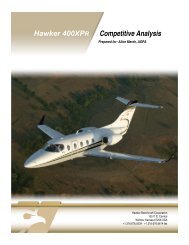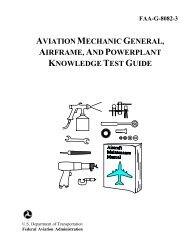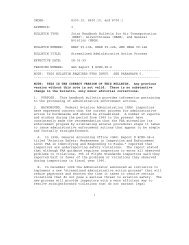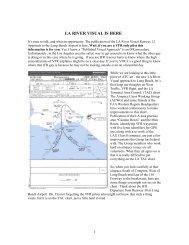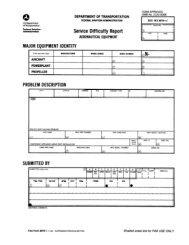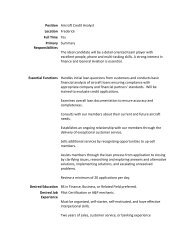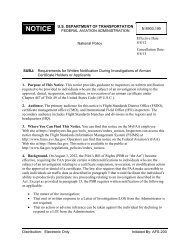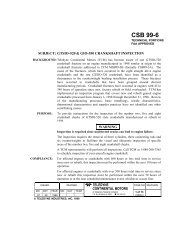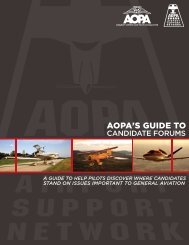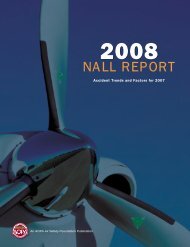Joseph T. Nall Report - Aircraft Owners and Pilots Association
Joseph T. Nall Report - Aircraft Owners and Pilots Association
Joseph T. Nall Report - Aircraft Owners and Pilots Association
Create successful ePaper yourself
Turn your PDF publications into a flip-book with our unique Google optimized e-Paper software.
Overview<br />
E X E C U T I V E<br />
4<br />
General aviation’s safety record continued<br />
the gradually improving trend<br />
that began several years ago. Overall,<br />
accidents were up slightly, fatal accidents were<br />
down slightly, <strong>and</strong> fatalities increased marginally.<br />
This was against the backdrop of increased<br />
flight hours, resulting in an estimated accident<br />
rate that is the lowest since record keeping began<br />
in 1938. This trend began in 1994 <strong>and</strong> although<br />
the decreases are small, it shows that the combination<br />
of improved technology <strong>and</strong> education<br />
appears to be working.<br />
However, GA pilots continue to have many<br />
accidents that defy logic, especially when they<br />
fall into the category of “normal flight operations.”<br />
Everyone underst<strong>and</strong>s that certain<br />
types of flying, such as aerial application,<br />
firefighting, <strong>and</strong> some types of law<br />
enforcement, involve risk that the average<br />
pilot does not face. Personal flying,<br />
people using airplanes for travel <strong>and</strong><br />
recreation, still has a disproportionate<br />
number of mishaps. Considering the<br />
nature of GA, that should not be surprising.<br />
The flexibility that is the trademark of<br />
this activity, the freedom to travel where <strong>and</strong><br />
when we please, puts additional burden on<br />
pilots to use that freedom wisely.<br />
In general terms, little has changed significantly<br />
since last year. Low-level maneuvering<br />
flight <strong>and</strong> weather remain the two largest fatal<br />
accident categories, as they have for the last<br />
decade. However, there has been a slight improvement<br />
in weather-related accidents <strong>and</strong> while we<br />
won’t call it a trend yet, the hope is that pilots are<br />
heeding the message that VFR flight into instrument<br />
conditions is not a life-prolonging activity.<br />
Do we need more study in this area? Perhaps,<br />
but what is really needed is for both new, inexperienced<br />
pilots <strong>and</strong> complacent, old graybeards to<br />
fully comprehend the risk <strong>and</strong> decide that no matter<br />
what the mission, their lives <strong>and</strong> those of their passengers<br />
are worth more than any schedule. ASF has<br />
had a massive education campaign underway for the<br />
past five years on weather decision making. We have<br />
conducted over 1,000 free seminars <strong>and</strong> given away<br />
thous<strong>and</strong>s of videotapes on the subject. These efforts<br />
will continue with the ASF SkySpotter program, a<br />
campaign to get pilots to submit a pilot report on<br />
every flight. This will improve our ability to forecast<br />
<strong>and</strong> nowcast the weather significantly.<br />
Low-level maneuvering fatalities fall into the<br />
easily preventable category <strong>and</strong> this became the<br />
leading fatal accident phase of flight for ’99.<br />
Hitting towers, wires, other objects, <strong>and</strong> the<br />
ground itself in VFR conditions is generally inexcusable<br />
with few exceptions. Likewise, stalling an<br />
aircraft close to the ground must be considered<br />
poor airmanship.<br />
To make the <strong>Nall</strong> <strong>Report</strong> both timely <strong>and</strong> accurate,<br />
we balance between the need to obtain the<br />
greatest number of fully completed accident<br />
reports <strong>and</strong> to publish as quickly as prudent.<br />
Traditionally, final accident reports make up the<br />
vast majority (over 80 percent) of the data with the<br />
balance of preliminary reports included for completeness.<br />
We believe that this practice has not significantly<br />
changed either numbers or percentages<br />
of the overall analysis in any particular area. To<br />
verify that assumption, a comparison was made<br />
between the projections in the 1999 <strong>Nall</strong> <strong>Report</strong> <strong>and</strong><br />
the result once all of the final reports were complete,<br />
which was late last year.<br />
In almost every case, both the pattern <strong>and</strong> the<br />
relationships between accident categories remained<br />
identical. For example, the projection for fatal<br />
maneuvering accidents was 18.8 percent. The final<br />
tally came in at 19.7 percent. The fatal weather accident<br />
prediction, based on pilot-related causes was<br />
21.9 percent <strong>and</strong> the verification was 19.2 percent.<br />
Investigation of fatal mechanical/maintenance<br />
accidents frequently takes longer <strong>and</strong> is an area<br />
where we had expected some variability. However,<br />
the final numbers did not change greatly <strong>and</strong> none<br />
of the relative positions changed significantly.<br />
This year, due to increasing flight activity, ASF,<br />
in cooperation with the FAA, will focus on collision<br />
avoidance. In flight <strong>and</strong> on the ground, pilots<br />
<strong>and</strong> instructors will be reminded of the need for<br />
vigilance. A fuel awareness campaign is also<br />
underway to reduce fuel exhaustion <strong>and</strong> starvation<br />
mishaps. Weather education programs will<br />
continue <strong>and</strong> a renewed assault on maneuvering<br />
flight accidents is contemplated.<br />
As always, our thanks to the FAA <strong>and</strong> NTSB<br />
staff without whose efforts this report would not<br />
be possible. Contributions from AOPA, individual<br />
pilot donors, <strong>and</strong> our corporate sponsors helped to<br />
underwrite this annual effort <strong>and</strong> we are most<br />
appreciative of their support.<br />
Let’s make this year the best one ever for<br />
general aviation safety.<br />
Safe <strong>Pilots</strong>. Safe Skies.<br />
Bruce L<strong>and</strong>sberg<br />
Executive Director<br />
AOPA Air Safety Foundation



